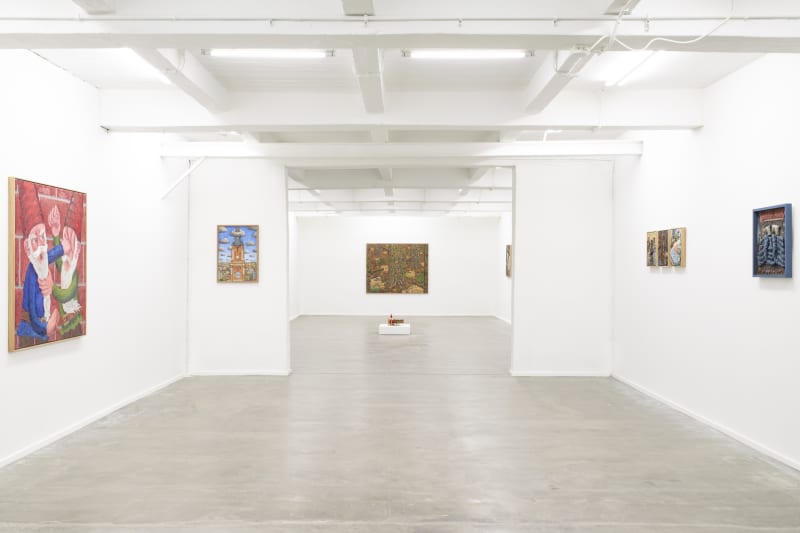floris van look: very important friends
Past exhibition
Overview
KETELEER GALLERY is very pleased to introduce Very Important Friends, a solo exhibition by Floris Van Look (°1990. Wilrijk, Antwerp). After receiving his bachelor’s degree in psychology from Ghent University in 2012, Floris wanted to explore alternative directions. He tried his hand at architecture but eventually decided to go and study painting at the Academy of Fine Arts, Antwerp. Floris quickly felt at home in the academy which offered a somewhat traditional education. Since graduating in 2018 Floris focused on figurative painting and managed to develop his own visual language. Floris usually lets his mind converse with the life he encounters on the streets, but last year’s enforced seclusion allowed him to look at his surroundings differently and to bring them and the literature he immerses himself in to life in a completely new series of oil and putty paintings.
Press release
In Floris Van Look’s paintings a small mutiny is taking place. In Double Nightmare the bedlinen comes to life at night, seemingly holding the dreaming sleepers in their grip. The pieces of fruit in the fruit bowl of The Gathering have woken up and are now listening eagerly to the stories of a gnome. In Carrousel another group of gnomes have climbed into the washing machine and is now tumbling through our towels, panties and bras in confusion… fantasy knows no limits, it always intrudes some level of reality, (de)forms it even.
When it comes down to it, our imagination is often our biggest threat: when it gets free reign, our self-generated ideas can quickly turn against us. Thus our greatest strength is also our greatest weak point. It’s a game of truth and value constructions which has the power to push entire countries into war and individuals into psychiatric wards. It’s precisely because man, with his unique talent for imagination, is the most gifted, dynamically creative and cultural force in nature, that Nietzsche called him the ‘sickest’ animal of all living creatures. Like a double edged sword the figments of our imagination are dangerous but indispensable Very Important Friends, they guide our emotions and those emotions guide our actions. It’s wise to keep an eye on what truly motivates us.
In the three small works The Nose, The Insect and The Breast classic novels are being portrayed by Nikolaj Gogol, Franz Kafka and Philip Roth – grandmasters of symbolism. Three examples of extreme derailments of fantasy in which the protagonist starts to question everything he sees and, eventually, his own sense of reality. Symbolism devours all normality in these stories, taking over not only the protagonist’s mind but also, literally, his entire body – a theme which also shows up in Face Wash. All certainties have gone out the window and the poor mutated protagonist is stuck in a game of hide-and-seek with his own sanity threatening to take him down.
In The Waiters the trees are looking at us, we’ve become trespassers in their world. Everyone who goes walking in nature will experience automatically slowing down, intuitively treading more gently, knowing that one enters a self-regulating age-old organism of invisible mechanisms, a mystery beyond our grasp: an awe-inspiring life force which proceeds us.
The inanimate also comes to life in Floris’ works, the church tower in The Lord’s Faces for example is also looking at us, grinningly perhaps, or are we just imagining things? Do we look for a face, ourselves in everything? Do we seek to humanize everything, is this the only way to understand things, as we also picture a God with a face and a beard? Or is there something to it after all, to experiencing things as though they have their own character? A church has unmistakable particularities, we ascribe it with a cluster of associations and symbolism and designed it for this purpose, to be a symbol for our values, this is how we assign it an identity and it is this identity which is – and indeed, in this secular age grinningly perhaps – staring back at us.
Floris’ works are extremely tactile, the surface is built up of very thick layers, voluptuous blobs even, of paint. Bordering a sculpture, some works are made almost entirely out of putty, an ‘outdated’ way to offer a 3D-experience. In the past people made diorama’s, pop-up books and later movies to bring stories to life, but since time immemorial, man has never not tried to turn the figments of his imagination into reality: statues of gods, churches as houses for the gods, music, theatre… all meant to make stories more tangible and thus more ‘real’. Virtual Reality is the latest development trying to meet this desire but its ambition is perhaps not that much more extreme than that of a cathedral. They both seek to create an immersive experience of a world beyond ours. The biggest difference resides in the fact that the space created is becoming more and more intangible, is paradoxically being dematerialised to feel even more real. Floris prefers to stick to old techniques and classical references but still succeeds wonderfully in inspiring our ‘hypermodern’ minds to fantasy.
Lauren Wiggers, 2020.
Installation Views
Works






















